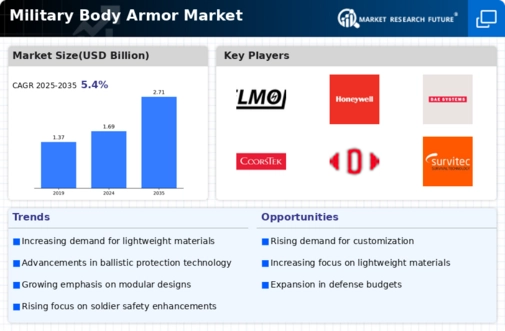Top Industry Leaders in the Military Body Armor Market

Key Players
Elmon (Greece)
Honeywell (US)
BAE Systems (UK)
Coorstek Inc. (US)
Du Pont (US)
Point Blank Enterprises Inc (US)
MKU Limited (India)
M (US Safariland
LLC (US)
Survitec Group Limited (UK)
Strategies Adopted
To maintain and expand their market share, key players have adopted various strategies. One prominent approach is continuous research and development to introduce innovative materials that enhance the protective capabilities of body armor. Additionally, strategic collaborations with defense agencies and partnerships with other industry leaders have become common, facilitating the exchange of knowledge and resources.
Factors for Market Share Analysis
Market share in the Military Body Armor sector is influenced by factors such as product quality, pricing, brand reputation, and the ability to meet evolving military requirements. Innovations in lightweight materials, providing both enhanced protection and increased mobility, have become a significant differentiator. Manufacturers that align with environmental sustainability and regulatory standards also gain a competitive edge in an increasingly conscientious market.
New and Emerging Companies
The landscape is witnessing the emergence of new players, often characterized by their focus on niche markets or disruptive technologies. Start-ups like ArmourGenix and Nanotech Armor are leveraging advancements in nanotechnology and smart materials to create next-generation body armor. These companies bring agility and a fresh perspective, challenging established norms and driving innovation.
Industry News
Recent industry news highlights the sector's responsiveness to geopolitical shifts and technological advancements. The adoption of exoskeletons integrated with body armor to enhance soldiers' strength and endurance has gained attention. Additionally, the exploration of 3D printing technologies for customized, lightweight armor solutions is on the rise. Such developments underscore the industry's commitment to staying ahead of evolving threats.
Current Company Investment Trends
Investment trends reflect the sector's focus on innovation and technological advancements. Companies are allocating significant resources to research and development, with a keen eye on materials science, artificial intelligence, and smart textiles. The quest for sustainable materials, coupled with a push towards digitization in armor manufacturing processes, is evident in recent investment patterns.
Overall Competitive Scenario
The competitive scenario in the Military Body Armor market is intense, marked by a balance between established players, striving to maintain their dominance, and new entrants disrupting traditional approaches. The emphasis on lightweight, yet robust materials reflects the industry's dedication to providing soldiers with the best possible protection without compromising mobility.
Recent News
DuPont de Nemours Inc. (DD)
Unveiled Kevlar EXO aramid fiber, a lighter and more flexible version of their flagship bullet-resistant material, offering enhanced protection without compromising mobility.
Secured a contract with the U.S. Army to supply Kevlar EXO for their next-generation Improved Outer Tactical Vest (IOTV), showcasing its potential for widespread adoption.
MKU Ltd.
Launched the next-generation Modular Ballistic Vest (MBV), featuring a scalable design allowing for customization and adaptation to diverse operational needs.
Partnered with Indian research institutions to develop bio-inspired materials for future body armor, aiming to improve protection and wearer comfort.
BAE Systems plc (BAE)
Introduced the VIRtus Lightweight Ballistic System, offering modularity, scalability, and integrated communication systems for modern soldiers.
Collaborating with universities to explore graphene-based composite materials for body armor, pushing the boundaries of ballistic protection.


